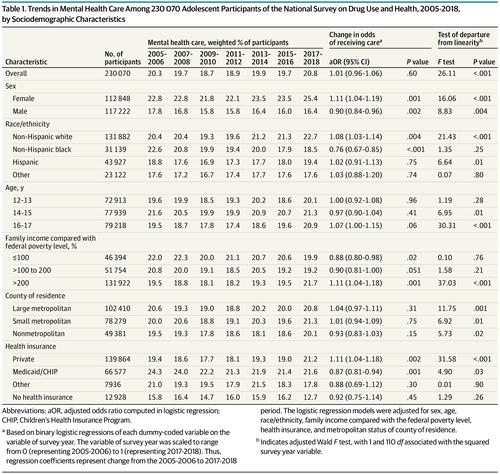JAMA Psychiatry ( IF 25.8 ) Pub Date : 2020-07-01 , DOI: 10.1001/jamapsychiatry.2020.0279 Ramin Mojtabai 1 , Mark Olfson 2

|
Importance The prevalence of adolescent depression and other internalizing mental health problems has increased in recent years, whereas the prevalence of externalizing behaviors has decreased. The association of these changes with the use of mental health services has not been previously examined.
Objective To examine national trends in the care of different mental health problems and in different treatment settings among adolescents.
Design, Setting, and Participants Data for this survey study were drawn from the National Survey on Drug Use and Health, an annual cross-sectional survey of the US general population. This study focused on adolescent participants aged 12 to 17 years interviewed from January 1, 2005, to December 31, 2018. Data were reported as weighted percentages and adjusted odds ratios (aORs) and analyzed from July 20 to December 1, 2019.
Main Outcomes and Measures Time trends in 12-month prevalence of any mental health treatment or counseling in a wide range of settings were examined overall and for different sociodemographic groups, types of mental health problems (internalizing, externalizing, relationship, and school related), and treatment settings (inpatient mental health, outpatient mental health, general medical, and school counseling). Trends in the number of visits and nights in inpatient settings were also examined.
Results A total of 47 090 of the 230 070 adolescents across survey years (19.7%) received mental health care. Of these, 57.5% were female; 31.3%, aged 12 to 13 years; 35.8%, aged 14 to 15 years; and 32.9%, aged 16 to 17 years. The overall prevalence of mental health care did not change appreciably over time. However, mental health care increased among girls (from 22.8% in 2005-2006 to 25.4% in 2017-2018; aOR, 1.11; 95% CI, 1.04-1.19; P = .001), non-Hispanic white adolescents (from 20.4% in 2005-2006 to 22.7% in 2017-2018; aOR, 1.08; 95% CI, 1.03-1.14; P = .004), and those with private insurance (from 19.4% in 2005-2006 to 21.2% in 2017-2018; aOR, 1.11; 95% CI, 1.04-1.18; P = .002). Internalizing problems, including suicidal ideation and depressive symptoms, accounted for an increasing proportion of care (from 48.3% in 2005-2006 to 57.8% in 2017-2018; aOR, 1.52; 95% CI, 1.39-1.66; P < .001), whereas externalizing problems (from 31.9% in 2005-2006 to 23.7% in 2017-2018; aOR, 0.67; 95% CI, 0.62-0.73; P < .001) and relationship problems (from 30.4% in 2005-2006 to 26.9% in 2017-2018; aOR, 0.75; 95% CI, 0.69-0.82; P < .001) accounted for decreasing proportions. During this period, use of outpatient mental health services increased from 58.1% in 2005-2006 to 67.3% in 2017-2018 (aOR, 1.47; 95% CI, 1.35-1.59; P < .001), although use of school counseling decreased from 49.1% in 2005-2006 to 45.4% in 2017-2018 (aOR, 0.86; 95% CI, 0.79-0.93; P < .001). Outpatient mental health visits (eg, private mental health clinicians, from 7.2 in 2005-2006 to 9.0 in 2017-2018; incidence rate ratio, 1.30; 95% CI, 1.23-1.37; P < .001) and overnight stays in inpatient mental health settings (from 4.0 nights in 2005-2006 to 5.4 nights in 2017-2018; incidence rate ratio, 1.18; 95% CI, 1.02-1.37; P = .03) increased.
Conclusions and Relevance This study’s findings suggest that the growing number of adolescents who receive care for internalizing mental health problems and the increasing share who receive care in specialty outpatient settings are placing new demands on specialty adolescent mental health treatment resources.
中文翻译:

美国青少年心理健康护理的国家趋势。
重要性 近年来,青少年抑郁症和其他内在的心理健康问题的患病率有所上升,而外在的行为的患病率却有所下降。这些变化与心理健康服务的使用之间的关联以前没有被检查过。
目的 研究青少年在不同心理健康问题和不同治疗环境中的护理趋势。
设计,设置和参与者 这项调查研究的数据来自全国药物使用和健康调查,这是一项针对美国普通人群的年度横断面调查。这项研究的重点是从2005年1月1日到2018年12月31日接受采访的12至17岁的青少年参与者。数据以加权百分比和调整后的优势比(aOR)进行报告,并从2019年7月20日至12月1日进行了分析。
主要结果和措施 总体上,针对不同的社会人口学群体,心理健康问题的类型(内在化,外在化,人际关系和与学校有关),全面检查了各种环境中任何心理健康治疗或咨询在12个月盛行的时间趋势,和治疗设置(住院病人的心理健康,门诊病人的心理健康,一般医疗和学校咨询)。还检查了住院情况下的就诊次数和夜晚数趋势。
结果 在整个调查年度的230 070名青少年中,有47 090名(19.7%)得到了心理保健。其中57.5%为女性;31.3%,年龄在12至13岁之间;35.8%,年龄14至15岁;和32.9%,年龄在16至17岁之间。随着时间的推移,精神卫生保健的总体流行率没有明显变化。但是, 非西班牙裔白人青少年的女孩中的精神卫生保健增加(从2005-2006年的22.8%增加到2017-2018年的25.4%; aOR为1.11; 95%CI为1.04-1.19; P = .001)从2005-2006年的百分比升至2017-2018年的22.7%; aOR为1.08; 95%的CI为1.03-1.14;P = .004)以及拥有私人保险的人(从2005-2006年的19.4%降至2017-2018年的21.2% 2018; aOR,1.11; 95%CI,1.04-1.18; P = .002)。内在化的问题,包括自杀意念和抑郁症状,在护理中所占比例不断增加(从2005-2006年的48.3%增至2017-2018年的57.8%; aOR为1.52; 95%CI为1.39-1.66; P <.001) ,而外部化问题(从2005-2006年的31.9%到2017-2018年的23.7%; aOR,0.67; 95%CI,0.62-0.73;P <.001)和关系问题(从2005-2006年的30.4%到26.9)在2017-2018年的百分比中; aOR为0.75; 95%CI为0.69-0.82; P <.001)占比下降。在此期间,门诊心理健康服务的使用率从2005-2006年的58.1%增加到2017-2018年的67.3%(aOR为1.47; 95%CI为1.35-1.59; P <.001),尽管学校辅导的使用从2005-2006年的49.1%降至2017-2018年的45.4%(aOR,0.86; 95%CI,0.79-0.93; P <.001)。门诊心理健康就诊(例如,私人心理健康临床医生,从2005-2006年的7.2增加到2017-2018年的9.0;发生率,1.30; 95%CI,1.23-1.37; P <.001)和住院的精神病患者过夜健康状况(从2005-2006年的4.0夜增加到2017-2018年的5.4夜;发生率,1.18; 95%CI,1.02-1.37; P = 0.03)。
结论与相关性 这项研究的发现表明,越来越多的因内在心理健康问题而接受护理的青少年,以及在专科门诊环境中接受护理的份额的增加,都对青少年青少年心理健康治疗资源提出了新的要求。


























 京公网安备 11010802027423号
京公网安备 11010802027423号